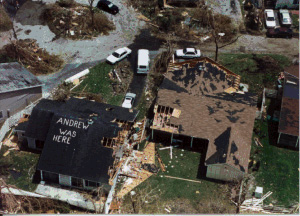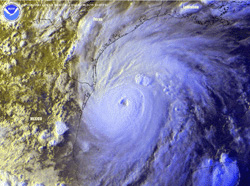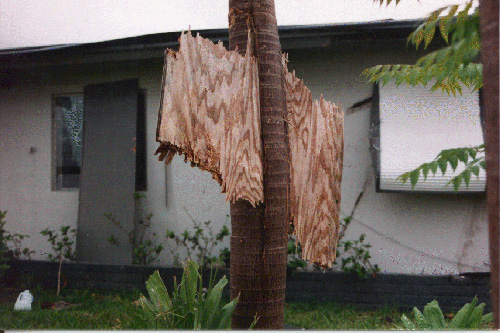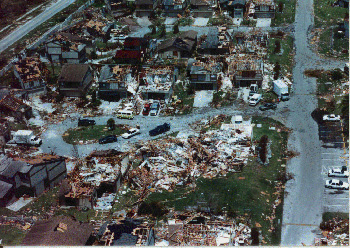| Although the
loss of life has dropped dramatically since 1900, hurricanes continue
to wreck havoc, costing millions of dollars in damage each year.
Courtesy
of NOAA
When Hurricane
Andrew of 1992 came booming ashore in South Florida, it caused the
United States' most expensive natural disaster $27 billion worth
of property destroyed. Loss of life was another matter. In Miami-Dade
County, Andrew killed only 15 people by direct force of wind and
water. Human casualties were so light because the storm caused little
flooding in populated areas and the National Hurricane Center forecast
the storm track accurately. Although hurricanes are inevitable on
the East Coast of North America, correct characterization of the
phenomenon on all scales enables men and women to prepare effectively.
Accurate forecasts of individual events give people time and motivate
them to act. The climatology of the threat's occurrence and severity
is the key to wise policies implemented long before the event. Intelligent
responses in the years, months, days, hours and even minutes before
hurricane landfall can limit human and material losses.
Impacts

NOAA
A
house in Miami is torn apart by Hurricane Andrew.
|
The simplest
characterization of hurricane intensity is embodied in the Saffir-Simpson
scale: from Category 1 - barely a hurricane - to Category 5 - the
worst imaginable. "Major Hurricanes" are those in Categories 3,
4, and 5 with winds stronger than 110 miles per hour equivalent
to 100 kt or 50 m s-1. Category 5 hurricanes are the most extreme
and also the most rare. Only two, the 1935 Labor Day Storm and Camille
in 1969 are recorded to have struck the United States. Andrew, at
the very top of Category 4 was the third strongest U.S. landfall,
and the second strongest on the mainland, given that the 1935 storm
hit the Florida Keys.
In the 20th century, U.S. hurricanes destroyed > $73 billion in
property, not corrected for inflation. During the 70-year period
from 1925 through 1995, the toll was $61 billion. If the damage
from historical hurricanes is normalized for inflation, increased
population, and greater individual wealth (Pielke and C. Landsea
1998), the estimate of total damage for the shorter period is $340
billion, equivalent to an average annual loss of $5 billion. During
these 70 years, 244 landfalls occurred. The average landfall would
have resulted in $1.5 billion in damage with today's prices and
costal development. But the average doesn't tell the story. Major
hurricanes accounted for 80% of the normalized damage, although
they represented only 20% of occurrence.
 NOAA
NOAA
Some
of the most damaging major hurricanes are predicted to occur
over the next two decades.
|
The 1995 through
1999 seasons inclusive have been the five most active in the > 100-year
quantitative climatology. Historically, hurricane landfalls on the
U.S. east coast were common during the 1940s through the mid 1960s.
In the 1970s and 1980s, landfalls were few. Now activity appears
to have returned to the high level that characterized the immediate
post-World War II period. These fluctuations in activity are most
pronounced for major hurricanes. They also correlate with the observed
"North Atlantic Mode", a coherent, multidecadal fluctuation of global
sea-surface temperatures. During the active portion of the long-term
record, Atlantic Sea-Surface Temperature (SST) anomalies in tropics
and high latitudes were warm, and conversely. If the hurricane climatology
and the Multi-Decadal Mode prove to be reliable guides, we may expect
the first decade or two of the 21st Century to produce as many of
the most damaging major hurricanes annually as the last 5 years
have.
In terms of hurricane-related mortality, the 20th Century started
badly. In Galveston Texas, on a single windy Saturday night, 9 September
1900, the "Great Hurricane" washed > 6,000 souls to their deaths.
The total mortality for the century was just a bit more than twice
this figure, 13,306 U.S. residents. During the first three decades
of the century, the average annual loss of life was 329, or discounting
the Galveston tragedy, 129. In the forty years from 1930 through
1969, it was 70. Since 1969, the average annual loss of life has
been < 20, notwithstanding a 10-fold increase in coastal population
from 1930.
The reason for the dramatic reduction has been effective warnings
and timely evacuation from coastal areas inundated by storm surge.
Invariably, large loss of life in hurricanes before 1970 stemmed
from wind-driven flooding. Since 1970 drowning from inland flooding
caused by torrential hurricane rains has come to predominate. Experience
shows that when storm surge (or wind for that matter) completely
flattens buildings, about 10% of the people present die. Evacuation
insures that virtually nobody is present. On the other hand, extreme
( > 30 cm in 6 hr) rainfall places a much larger population at individually
smaller risk. For example, Hurricane Floyd, the deadliest U.S. hurricane
since Agnes of 1973, killed 49 of the more than 5 million people
that it affected in the North Carolina Coastal Plain and Piedmont,
for an average risk of dying of less than one in a hundred thousand.
People in the developing world, who generally do not have the benefit
from farsighted land-use policies or effective building standards,
are at greater risk. The tragedy of Hurricane Mitch of 1998, which
took 10,000 lives in Honduras, demonstrates that among the many
bad consequences of poverty is vulnerability to natural disaster.
How do you find an extra-solar planet?
Dynamics
 NOAA
NOAA The
power of a hurricane has caused a piece of debris to slice
through a tree.
|
Hurricanes
are nearly circular, warm-core vortices, characteristically 1000
km in radius. Strong winds and precipitation are concentrated near,
but not at, their centers. Coincident with strongest winds, convective
updrafts, fed by inward spiraling surface winds, release latent
heat drawn from the ocean to power the storm. The clear eye, 15-30
km in radius, contains the axis of vortex rotation and is surrounded
by this ring of strong winds. The eye is characterized by the warmest
temperatures in the vortex, low humidity, low pressure, in extreme
cases > 10% below that in the undisturbed tropical atmosphere, and
calm winds at the very center. The hurricane's eye presents one
of the truly magnificent vistas offered to human sight, and the
hurricane's workings delight the mind as an intricate and subtle
problem in hydrodynamics.
In the center
of the hurricane is the cloud-free eye. The clouds that enclose
the eye form the eyewall. These clouds draw air from the eye at
low levels, causing descent, drying, and warming inside the eye.
As the air warms, it becomes less dense so surface pressure must
fall. The clouds also draw air inward from outside the eye, thus
concentrating the counter-clockwise rotation and increasing the
swirling winds. In a hurricane, the strongest winds are near the
surface and just outside the eyewall. An unanticipated use of the
new GPS sondes was direct observation of low-level wind jets at
the inner edge of the eyewall.
A typical hurricane
intensifies slowly, remaining in Category 1 or reaching 2 or even
3 before it runs ashore or drifts north out of the tropics. The
strongest hurricanes, such as Andrew in 1992, intensify rapidly
and go from Category 1 or 2 to Category 4 or 5 in just a day or
two. The process that initiates rapid intensification may begin
with atmospheric waves that form on the hurricane vortex at altitudes
of greater than 12 kilometers (where the new jet will fly). These
waves result from interaction with nearby low-pressure systems.
The waves, through a complicated chain of cause and effect, intensify
the cumulus clouds that are involved in the energy conversion mechanisms
of a hurricane.
Modification?
 NOAA
NOAA
It
is unlikely unlikely that human intervention will ever prevent
hurricanes.
|
Can human intervention diminish the force of a hurricane? From
the mid-1960s through the early 1980s NOAA actively pursued Project
STORMFURY, a program of experimental hurricane modification. The
general strategy was to reduce the intensity of the storm by cloud
seeding. The seeding, it was argued, would stimulate the formation
of a new eyewall that would surround the existing eyewall. The new
eyewall would contract, strangling the old eyewall and reducing
the intensity of the hurricane. However, research carried out at
AOML showed clearly that these "concentric eyewalls" happened often
in unmodified hurricanes, thus casting doubt on the seemingly positive
results of seeding in earlier experimentation. Hurricane Luis provides
an example of this behavior. Moreover, observations showed that
hurricanes contain little of the supercooled water necessary for
cloud seeding to work.
The American Meteorological Society policy statement on planned
and inadvertent weather modification, dated October 2, 1998, indicates,
"There is no sound physical hypothesis for the modification of hurricanes,
tornadoes, or damaging winds in general, and no related scientific
experimentation has been conducted in the past 20 years." In the
absence of a sound hypothesis, no Federal agencies are presently
doing, or planning, research on hurricane modification.
During
the 40 years between 1930 and 1959, inclusive, 70 people a year
died in the U.S. hurricanes. Since 1950, the midpoint of this interval,
population in the 109 coastal counties between Texas and Virginia
had increased by a factor of 3.4. If the forecaster's art had not
improved during the last century, expected annual mortality to this
larger population from hurricanes would be 238, with an economic
impact of $1785M. By this estimate the stakes of the annual hurricane
game are $8.9B, of which $2.8B, or 31%, is prevented through an
investment of < $0.22B in forecasting and research, for a greater
than twelve to one favorable benefit to cost ratio. The prevented
impact is dominated by reduced mortality.
|
